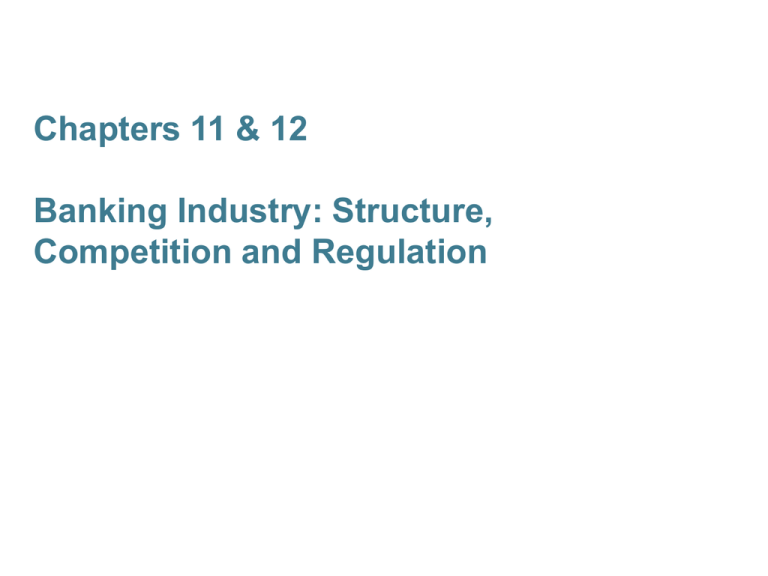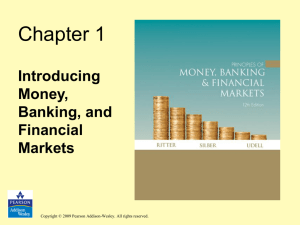
Chapters 11 & 12
Banking Industry: Structure,
Competition and Regulation
Financial Innovation
Innovation is result of search for profits
Response to Changes in Demand
Major change is huge increase in interest-rate risk starting in 1960s
Example: Adjustable-rate mortgages
Financial Derivatives
Response to Change in Supply
Major change is improvement in computer technology
1. Increases ability to collect information
2. Lowers transaction costs
Examples:
1. Bank credit and debit cards
2. Electronic banking facilities
3. Junk bonds
4. Commercial paper market
5. Securitization
10-2
Avoidance of Existing Regulations
Regulations Behind Financial Innovation
1. Reserve requirements
Tax on deposits = i r
2. Deposit-rate ceilings (Reg Q till 1980)
As i , loophole mine to escape reserve
requirement tax and deposit-rate ceilings
Examples
1. Money market mutual funds (Bruce Bent)
2. Sweep accounts
© 2004 Pearson Addison-Wesley. All rights reserved
10-3
The Decline in Banks
as a Source of Finance
© 2004 Pearson Addison-Wesley. All rights reserved
10-4
Decline in Traditional Banking
Loss of Cost Advantages in Acquiring Funds
(Liabilities)
i then disintermediation because
1. Deposit rate ceilings and regulation Q
2. Money market mutual funds
3. Foreign banks have cheaper source of funds: Japanese
banks can tap large savings pool
Loss of Income Advantages on Uses of Funds
(Assets)
1. Easier to use securities markets to raise funds:
commercial paper, junk bonds, securitization
2. Finance companies more important because easier for
them to raise funds
10-5
Banks’ Response
Loss of cost advantages in raising funds and
income advantages in making loans causes
reduction in profitability in traditional banking
1. Expand lending into riskier areas: e.g., real estate
2. Expand into off-balance sheet activities
3. Creates problems for U.S. regulatory system
Similar problems for banking industry in other
countries
© 2004 Pearson Addison-Wesley. All rights reserved
10-6
Structure of the Commercial Banking
Industry
© 2004 Pearson Addison-Wesley. All rights reserved
10-7
Table 1 Size Distribution of Insured
Commercial Banks, September 30, 2008
© 2004 Pearson Addison-Wesley. All rights reserved
10-8
Ten Largest U.S. Banks
© 2004 Pearson Addison-Wesley. All rights reserved
10-9
Branching Regulations
Branching Restrictions: McFadden Act and
Douglas Amendment
Very anticompetitive
Response to Branching Restrictions
1. Bank Holding Companies
A. Allowed purchases of banks outside state
B. BHCs allowed wider scope of activities by Fed
C. BHCs dominant form of corporate structure for banks
2. Automated Teller Machines
Not considered to be branch of bank, so networks
allowed
© 2004 Pearson Addison-Wesley. All rights reserved
10-10
Bank Consolidation and Number of
Banks
© 2004 Pearson Addison-Wesley. All rights reserved
10-11
Bank Consolidation and
Nationwide Banking
• The number of banks has declined over the last 25
years
– Bank failures and consolidation.
– Deregulation: Riegle-Neal Interstate Banking and
Branching Efficiency Act f 1994.
– Economies of scale and scope from information
technology.
• Results may be not only a smaller number of banks
but a shift in assets to much larger banks.
© 2004 Pearson Addison-Wesley. All rights reserved
10-12
Benefits and Costs of Bank
Consolidation
• Benefits
– Increased competition, driving inefficient banks out
of business
– Increased efficiency also from economies of scale and scope
– Lower probability of bank failure from more diversified
portfolios
• Costs
– Elimination of community banks may lead to less lending to
small business
– Banks expanding into new areas may take increased risks and
fail
© 2004 Pearson Addison-Wesley. All rights reserved
10-13
Separation of Banking and
Other Financial Service Industries
Erosion of Glass-Steagall
Fed, OCC, FDIC, allow banks to engage in underwriting
activities
Gramm-Leach-Bliley Financial Modernisation Services
Act of 1999: Repeal of Glass-Steagall
1. Allows securities firms and insurance companies to purchase banks
2. Banks allowed to underwrite insurance and engage in real estate
activities
3. OCC regulates bank subsidiaries engaged in securities
underwriting
4. Fed oversee bank holding companies under which all real estate,
insurance and large securities operations are housed
Implications: Banking institutions become larger and more complex
10-14
How Asymmetric Information
Explains Banking Regulation
1. Government Safety Net and Deposit Insurance
A. Prevents bank runs due to asymmetric information:
depositors can’t tell good from bad banks
B. Creates moral hazard incentives for banks to take on too
much risk
C. Creates adverse selection problem of crooks and risk-takers
wanting to control banks
D. Too-Big-to-Fail increases moral hazard incentives for big
banks
2. Restrictions on Asset Holdings
A. Reduces moral hazard of too much risk taking
© 2004 Pearson Addison-Wesley. All rights reserved
10-15
How Asymmetric Information
Explains Banking Regulation
3. Bank Capital Requirements
A. Reduces moral hazard: banks have more to lose when have
higher capital
B. Higher capital means more collateral for FDIC
4. Bank Supervision: Chartering and Examination
A. Reduces adverse selection problem of risk takers or crooks
owning banks
B. Reduces moral hazard by preventing risky activities
5. New Trend: Assessment of Risk Management
6. Disclosure Requirements
A. Better information reduces asymmetric information
problem
© 2004 Pearson Addison-Wesley. All rights reserved
10-16
How Asymmetric Information
Explains Banking Regulation
7. Consumer Protection
A. Standardized interest rates (APR)
B. Prevent discrimination: e.g., CRA
8. Restrictions on Competition to Reduce Risk-Taking
A. Branching restrictions
B. Separation of banking and securities industries in the past:
Glass-Steagall
International Banking Regulation
1. Bank regulation abroad similar to ours
2. Particular problem of regulating international banking
e.g., BCCI scandal
© 2004 Pearson Addison-Wesley. All rights reserved
10-17






